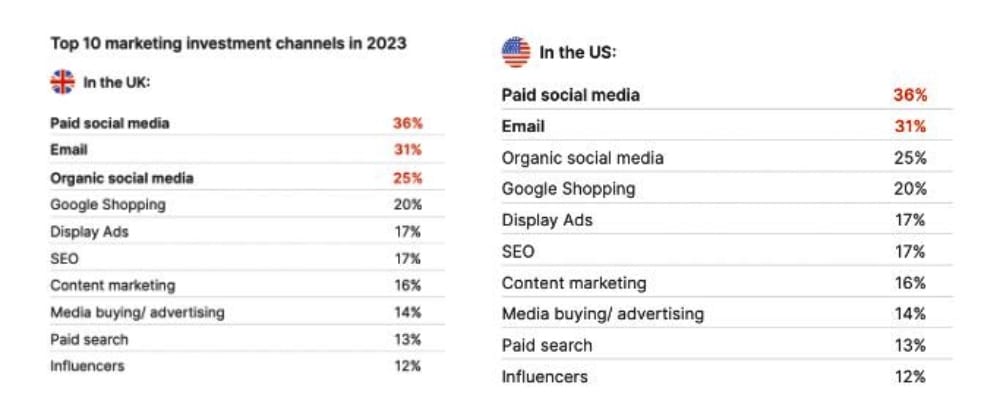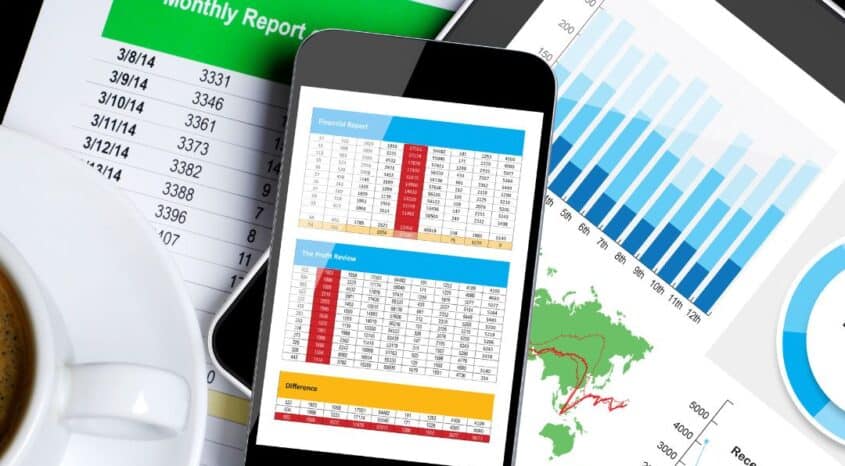Remember when throwing some cash behind a few Facebook ads was enough to get great results rolling in?
Ahh, those were the days!
In 2023, amidst a gloomy economic outlook, rising operational costs, low cash reserves and privacy changes, marketing is much less straightforward – and much more expensive.
The industry has changed more in the last three years than in the last 50 years, according to marketers that contributed to a Hubspot survey.
And fascinating research unveiled in our own brand new report shows the average marketing spend in the last 12 months has increased by 24% in the UK and 41% in the US.
In fact, current customer acquisition cost (CAC) for the average e-commerce brand stands at a whopping £107 (in the UK) and $121 (in the US).
See a breakdown of our this research by sector and business size in the full report available now (for free!)
A smarter way to spend
Although costs are rising, a bigger marketing spend isn’t necessarily turning into better results; some brands are seeing advertising costs increase by as much as 60% to drive the same amount of traffic.
Businesses that have previously blown their advertising budget on Meta platforms and PPC are now facing the realization that it’s no longer an affordable or effective strategy.
Spending wild amounts on acquisition for a diminishing return will become an even bigger risk during 2023 as Google’s new cookie legislation comes into play (in case you missed it, the search engine will soon join the ranks of Mozilla and Microsoft by blocking third-party cookies, which track users’ internet activity and allow digital publishers to target advertising).
A smarter way to spend each and every marketing dollar is now essential.
The problem is, many merchants have a shocking lack of insight into where their marketing spend is going and what it’s achieving.
It’s critical that merchants focus their energy and budget on channels that deliver the best ROI – but right now many simply don’t know which those channels are. Or, if they do know which channels are doing well, they don’t know why that is.
This year, that will have to change. Merchants will need to make data-driven decisions, backed up by reliable retail analytics, about the best channels to invest in to boost profit-based growth (and not just ‘growth at any cost’).
As Sara Arthrell, CMO at Brightpearl by Sage, writes in our new report: “Merchants need to adopt new strategies that allow them to navigate rising customer acquisition costs by diversifying their ad spend and successfully maximizing their CAC dollar by targeting new and existing customers more cost-effectively.
“They need a clear view on ROI from each channel, and better understanding on what spend should look like to maximize sales. From our insights, it’s clear that e-commerce businesses are crying out for that type of intel in the form of analytics, benchmarking and competitive analysis.
“This presents a great opportunity for this year – the ability to embrace intelligence to maximize ROI, while lowering marketing costs by using retail analytics technology.”
What Are The Best Profit-Driving Channels in 2023?
Can paid social still be counted on to help merchants achieve their goals, even as acquisition costs soar? Or will merchants need to place increased focus on more affordable and less risky channels to maximize the return on their CAC spend?
Our research shows paid social remains the number one channel brands plan to invest in this year, but that other channels are being added into the mix as merchants seek a return to more traditional or more cost effective ways to target new and existing customers.
The key to truly getting the best bang for your marketing buck in 2023 is to use a marketing analysis and benchmarking tool to see which channels are most effective for your business (and how your results compare to the competition).
However, there are some general observations on the best channels to drive profit in 2023 that can be made…
As third-party cookies are further eliminated, first-party data (data which a brand collects, with consent, directly from its customers) will become increasingly important. That’s why email is a top marketing channel for lots of brands in 2023.
The beauty of email is that it’s an ‘owned’ channel – which means you’re in charge of deciding how, when and why to contact your subscribers. Of course, that doesn’t mean bombardment will work as subscribers wield the power of being able to unsubscribe at any time.
Whether its newsletters, product launches or card abandonment emails, personalisation is key – as is properly segmented subscriber lists (so that you only send the emails that recipients actually want to read).
However, it’s no longer enough to just add in a first-name greeting. In 2023 and beyond, hyper-segmentation and hyper-personalization will become the focus of email strategy – though this will need to be balanced with a respect for customer privacy.
Fully interactive emails are the goal for many brands this year, enabling customers to complete actions and even sales without leaving the email.
Influencers
Influencer marketing is a way of generating brand awareness and social proof by recruiting content creators with a stand-out presence on social media to endorse, mention and advertise your brand.
It’s been a marketing trend for years, but in 2023 it’s set to become even more important. However, it’s no longer all about bringing mega influencers with millions of followers on board; micro-influencers are playing an increasingly important role.
The key for brands looking to start or step up their influencer marketing in 2023 is to find influencers with dedicated, engaged followings that are truly relevant to your audience or industry.
SEO
Search engine optimization (SEO) is a way of setting your website (or website content) to rank higher on a search engine results page (SERP) in order to increase traffic.
More than half (53.3%) of all website traffic comes from organic search and SEO drives 1,000%+ more traffic than organic social media, according to BrightEdge.
SEO leads are already known to have a higher close rate than other channels but, as the cost of PPC advertising rises, SEO will become an even more crucial marketing approach in 2023 as even though keyword strategy can be time-consuming it’s relatively low-cost.
As algorithms evolve and SEO becomes more complex, many merchants bring in SEO marketing agencies to handle this channel.
Content marketing (inc. video)
From blogs and organic social posts to short and longer form video, content marketing is a powerful tool that should be in every merchant’s marketing toolkit this year.
A multi-faceted approach to content marketing is a proven way to establish your business as an authority, as well as building brand awareness, driving traffic and playing a key part in your conversion funnel.
Short-form video is set to be a particularly rewarding channel, especially as social platforms like TikTok prioritize short form clips – which makes it a great option for reaching new customers.
Social media
The global spending on goods and services through social media platforms is expected to exceed $1 trillion.
It’s for this reason that, despite soaring acquisition costs, social media remains an unavoidable element of every marketing strategy in 2023.
The top five social platforms will include:
- YouTube
- TikTok
While spending on marketing across these platforms is inevitable, the key is to understand the ROI it delivers through advanced analysis. Benchmarking insights can help you see how this compares to others in your industry, and help you decide whether your funds could be better spent elsewhere.





